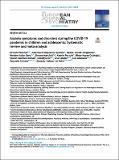Por favor, use este identificador para citar o enlazar a este item:
http://hdl.handle.net/10261/349663COMPARTIR / EXPORTAR:
 SHARE
BASE SHARE
BASE
|
|
| Visualizar otros formatos: MARC | Dublin Core | RDF | ORE | MODS | METS | DIDL | DATACITE | |

| Título: | Anxiety symptoms and disorders during the COVID-19 pandemic in children and adolescents: Systematic review and meta-analysis |
Autor: | Panchal, Urvashi; Vaquerizo-Serrano, Julio David; Conde-Ghigliazza, Ileana; Genç, Herdem Aslan; Marchini, Simone; Pociute, Kamile; Ocakoğlu, Binay Kayan; Sánchez-Román, Szarah; Ori, Dorottya; Catalán, Ana; Alameda, Luis; Cortese, Samuele; Salazar de Pablo, Gonzalo | Palabras clave: | Anxiety Children Adolescents COVID-19 |
Fecha de publicación: | dic-2023 | Editor: | Elsevier | Citación: | European Journal of Psychiatry 37(4): 100218 (2023) Sociedad Española de Psiquiatría y Salud Mental |
Resumen: | [Background and Objectives] The COVID-19 pandemic and its associated factors have been shown to affect anxiety levels of young people. We meta-analytically assessed the prevalence of anxiety symptoms and anxiety disorders in children and adolescents during the pandemic, and the predictors and moderating factors influencing anxiety. [Methods] Multiple databases and registers were searched in this PRISMA and MOOSE-compliant systematic review and meta-analysis (PROSPERO:CRD42021266695) until 27/06/2021. We included individual studies evaluating the prevalence and characteristics of anxiety symptoms or anxiety disorders in children and adolescents (mean age ≤18 years), during the COVID-19 pandemic. Data extraction and quality assessment were carried out by independent authors. Random-effects meta-analyses of the prevalence of anxiety symptoms and anxiety disorders were conducted using Comprehensive Meta-Analysis (CMA) V3. [Results] 74 articles (total participant sample=478,882) were included (mean age=13.4 years, 52.3% female). The pooled rate of children and adolescents fulfilling diagnostic criteria for anxiety disorders was 13.0% (95%CI=4.9–30.1); the pooled prevalence of anxiety symptoms was 26.5% (95%CI=20.3–33.9). Anxiety symptoms were significantly more prevalent in females than males (B = 0.103, p<.001), significantly higher during the second wave of COVID-19, following July 2020, than during the first wave, prior to June 2020, (Q= 8.136, p=.017), and during school closure (Q= 8.100, p=.014). Quality of included studies was overall moderate. [Conclusions] There is a high prevalence of anxiety symptoms in children and adolescents during the COVID-19 pandemic, especially amongst females. This study identifies vulnerable groups, risk, and protective factors, which is crucial to developing clinical practice to prevent further mental health deterioration in young people. |
Descripción: | © 2023 The Author(s). Published by Elsevier España, S.L.U. on behalf of Sociedad Española de Psiquiatría y Salud Mental. This is an open access article under the CC BY license (http://creativecommons.org/licenses/by/4.0/). | Versión del editor: | https://doi.org/10.1016/j.ejpsy.2023.06.003 | URI: | http://hdl.handle.net/10261/349663 | DOI: | 10.1016/j.ejpsy.2023.06.003 | ISSN: | 0213-6163 | E-ISSN: | 2340-4469 |
| Aparece en las colecciones: | (IBIS) Artículos (PTI Salud Global) Colección Especial COVID-19 |
Ficheros en este ítem:
| Fichero | Descripción | Tamaño | Formato | |
|---|---|---|---|---|
| Anxiety_EJP_2023_OA.pdf | 1,23 MB | Adobe PDF |  Visualizar/Abrir |
CORE Recommender
Page view(s)
17
checked on 28-may-2024
Download(s)
3
checked on 28-may-2024
Google ScholarTM
Check
Altmetric
Altmetric
Este item está licenciado bajo una Licencia Creative Commons

